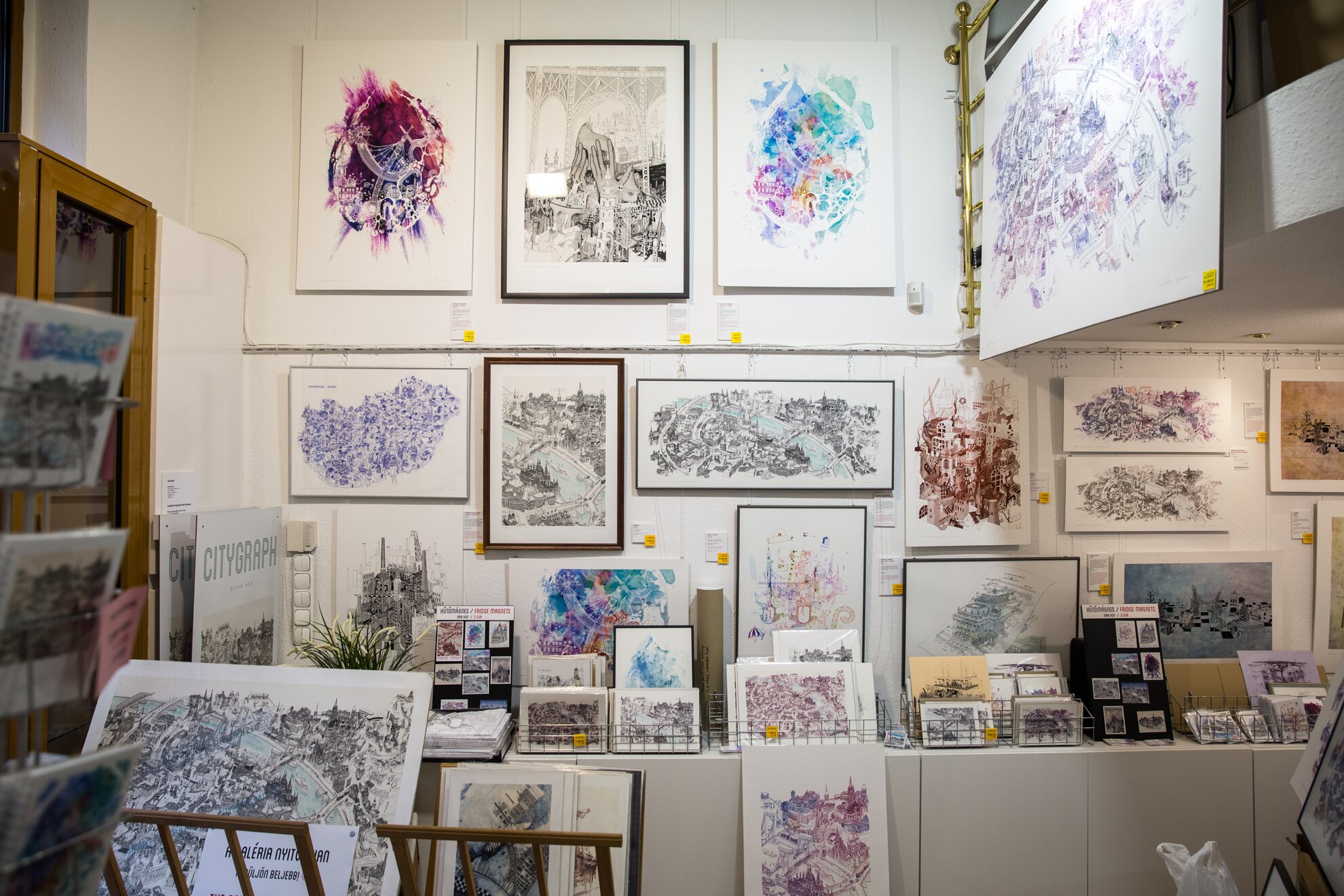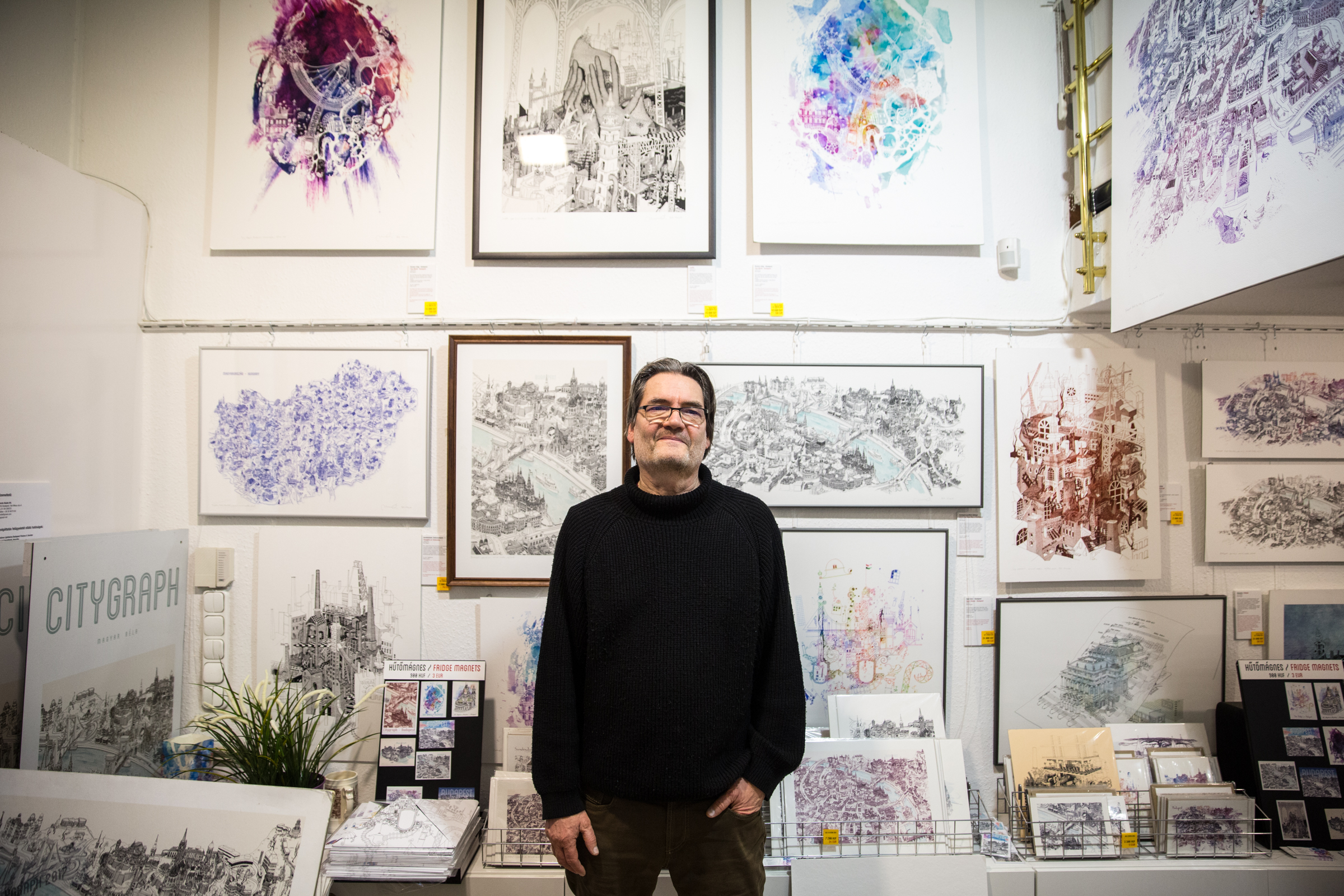A vivid collection of detailed drawings brightens this recently opened Budapest art gallery, a tiny outlet distinct from the vintage art shops of Falk Miksa Street. Instead of elaborate 19th-century paintings, customers at Citygraph find images of Budapest created with painstaking precision. Pictures on display present the vast variety of Budapest’s skyline as envisioned from a bird’s-eye perspective, while other graphics feature more than a pinch of Surrealism.

Citygraph artist Béla Magyar moved to Budapest as a child. Besides developing a deep affinity for the city, he also found his passion for drawing. “I graduated as an architect, but I soon realized that I didn’t want to practice this profession. For a while, I was creating covers for various journals. I began working on sketches for my own entertainment in the mid-1970s, but I gave it up for in the mid ’80s to focus on graphic arts, designing logos and websites. During my 25 years as a graphic designer, I didn’t draw a single line with a pen”.

After a downward spiral in his life, the artist finally turned back to his obsession: drawing. “I began scanning my old images to alter them using new digital technology. Ninety percent of the illustrations you see in this gallery were created during the ’70s and ’80s. These days, I’m just adding more detail to the original drawings, but now instead of paper and ink, I use a digital pen on a tablet. It’s still all done in freehand.”
While Magyar is musing about his life, a small group of customers enter the shop, browsing for a while, one leaving with a fridge magnet from the Citygraph collection.

Venturing into new fields with his old artworks, Magyar saw a niche in the market. “I discovered that many of Budapest’s souvenir shops sold kitschy keepsakes. I decided to offer something different, so I joined varied city fairs to sell my Budapest illustrations printed on T-shirts, mugs, canvas bags, notebooks and fridge magnets. My original drawings were just to decorate the stall.”

Magyar’s career turned a corner when a customer asked if he could buy one of the more surreal artworks that hadn't been put out for sale. “I was already in my ’50s when I understood that for most of my life I had been working according to what people expected me to do,” he says. Magyar now wants to let his souvenir range carry on but shift his focus onto his pictures. “Mementos won’t give me artistic freedom,” he points out.

The Citygraph gallery opened in 2017 as Magyar’s first standalone shop. This pocket-sized outlet is dominated by framed illustrations, showing urban panoramas from a soaring perspective, mostly Budapest cityscape. “When you take a closer look at this image, you quickly discover that nothing is exactly true to life in the picture,” Magyar explains, as he points to one of his Budapest features. “This is not exactly how the city looks, the buildings appear different, the bridges are further apart from each other and Budapest has many more streets compared to the ones that I illustrated here. However, after a brief glance, the viewer immediately sees that it represents Budapest.”

While adding plenty of playful specifics to a picture, Magyar tends to meticulously highlight specific details on the structures he draws. “I acquired a handy technique from writer Gabriel García Márquez, who often accentuated details that were seemingly less important. When I build up my artworks, I often focus on certain particulars of a building, such as the brickwork or the windows”.

The Colombian author was not the only one who had a great impact on Magyar. “I gain inspiration from painters like Salvador Dalí and Max Ernst,” he says. And as we carefully study the Magyar master’s merchandise, we discover touches of Surrealism blended into many of his works. One piece called Judit features the face of a real-life person against an industrial backdrop, a theme permeating many of the artist’s works – with a little trace of Budapest, of course.

“My all-time favorites are abandoned factory buildings. In my eyes, they are living organisms. It might have something to do with my roots,” says the artist, originally from Miskolc, a former stronghold of heavy industry in north-east Hungary. As the shop owner prepares relics created decades ago ready for sale, lots of new ideas pop up in his head, resulting in multiple varieties of a single drawing.

While the artist’s original artworks were exclusively created in black and white, the new digitalized versions feature a brilliant color scheme. “In the past, I found colors distracting, but since then I’ve gone through some kind of personal development. I don’t see the world in black and white any more”.




